Crushed concrete: The pros, cons and FAQs

Article updated October 10, 2025
What is crushed concrete, how is it made and what can I use it for?
Using crushed concrete in your projects is a more environmentally friendly choice as it keeps concrete from being dumped in landfills. It’s also a more affordable alternative to quarried stone. Lots of contractors even make their own recycled crushed concrete by buying a crusher like the one below. Want to find out how you can make your own crushed concrete?
Crushed concrete, often called recycled concrete aggregate (RCA), has become one of the most cost-effective and sustainable alternatives to traditional stone and gravel. This material is ideal for base layers, driveways, and backfill because it combines durability with drainage performance.
Crushed concrete is a building material that is used for lots of different construction and hardscape projects. It's made by crushing down old, concrete structures like roads, sidewalks, curbs, buildings and driveways into smaller pieces. It’s also known in the industry as ‘RCA’ - Recycled Concrete Aggregate.
The process involves using industrial crushers and screeners to break concrete down to specific size ranges. The resulting aggregate can then be reused in construction and landscaping projects, reducing the need for new quarry mining and helping contractors cut costs on material purchases.
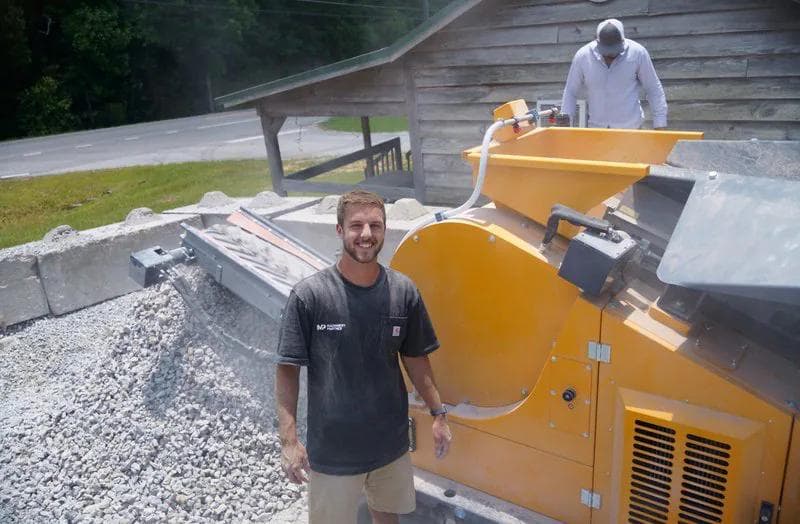
Because RCA is made from previously poured material, it often contains small amounts of sand, crushed stone, and mortar. These components that actually enhance its compaction and stability when reused as base material.
Crushed concrete can be used in landscaping projects for pathways, driveways and patios, as well as drainage ditches or pond edges. It can be made into blocks for foundations and retaining walls or even mixed with asphalt for use in paving projects. But, before you start using crushed concrete, you will want to check out the rest of this blog ... so you know all the pros and cons of using it in your next project!
Many construction crews also blend crushed concrete with crushed asphalt to create hybrid materials that improve flexibility and reduce cracking—especially useful for driveways and parking pads.

Pros of using crushed concrete
It’s an amazing resource that can be used in lots of different construction, hardscape and landscape projects.
Crushed concrete performs exceptionally well as a structural base material. It’s commonly used beneath roads, patios, and building foundations because it compacts tightly and resists shifting. For heavy-duty applications, larger RCA pieces are ideal, while finer grades serve as leveling or fill layers.
Save money on material
Using crushed concrete instead of gravel or stone is a great way to save money without sacrificing quality. It can be up to 50% cheaper, which means you can stretch your budget further and invest in other projects or new machinery.
Lots of contractors take their leftover waste concrete from driveways, walls and more, and pass it through a crusher or shredder to turn it into crushed concrete. This way, they don't have to pay extra for concrete or other aggregates bought directly from suppliers! They also don’t have to worry about running out of stock as they already have it on their job sites.
When you recycle concrete on-site using a mobile crusher, you cut both hauling and tipping costs. For small to mid-sized contractors, that can mean saving thousands annually while keeping materials in circulation instead of sending them to the landfill.
Are you thinking of making your own crushed concrete? Speak to a Machinery Partner Expert today - we have already helped people like Fabian to start their businesses!
Additional benefit: Recycled concrete is often classified by size, such as 3-inch down to fines, and it can replace quarry stone for road base, structural fill, or drainage layers. This versatility makes RCA a valuable, cost-effective aggregate for multiple construction uses.
Reduce landfill waste & be more sustainable
Using crushed concrete is a smart way to save money and reduce the amount of waste sent to landfills. As the availability of raw materials for making new concrete decreases, the cost of those materials will continue to rise. Crushing your existing concrete makes economic sense, and helps to minimize our impact on the environment by reducing the need for new mining or extraction of natural materials.
By diverting waste concrete from landfills, contractors can meet recycling requirements for LEED-certified projects and contribute to sustainable building goals. Many municipalities now encourage or even require using recycled aggregate as a substitute for virgin materials in road base and public infrastructure.
It is also a great way to save money on tipping fees from sending waste concrete to landfills. Crushing it yourself also means you don't have to hire extra truck drivers for transportation and you will save on fuel expenses!
On-site crushing also reduces heavy truck traffic between job sites and quarries, cutting fuel emissions and equipment wear. For companies running multiple projects, this operational efficiency can have a measurable environmental and financial impact.
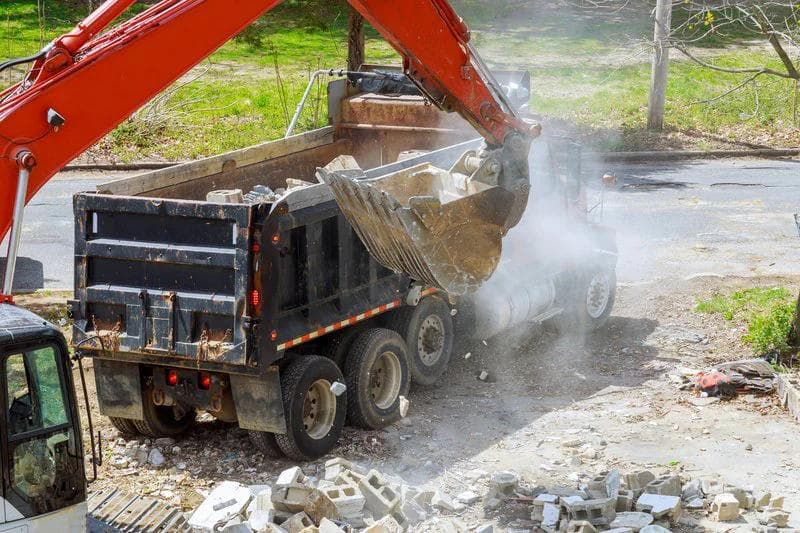
Use it on lots of projects
It’s super versatile and can be used to fill, grade, or stabilize material beneath roads, parking lots, and other paved areas. Crushed concrete is also often used for drainage structures, roadway curbs, retaining walls, and in landscaping where it allows moisture to pass through soil more easily.
Other common uses include riprap for erosion control, subbase for concrete slabs, and pipe bedding where water flow needs to be managed effectively. Because of its permeability and strength, recycled concrete aggregate is frequently used in stormwater management systems and green infrastructure projects.
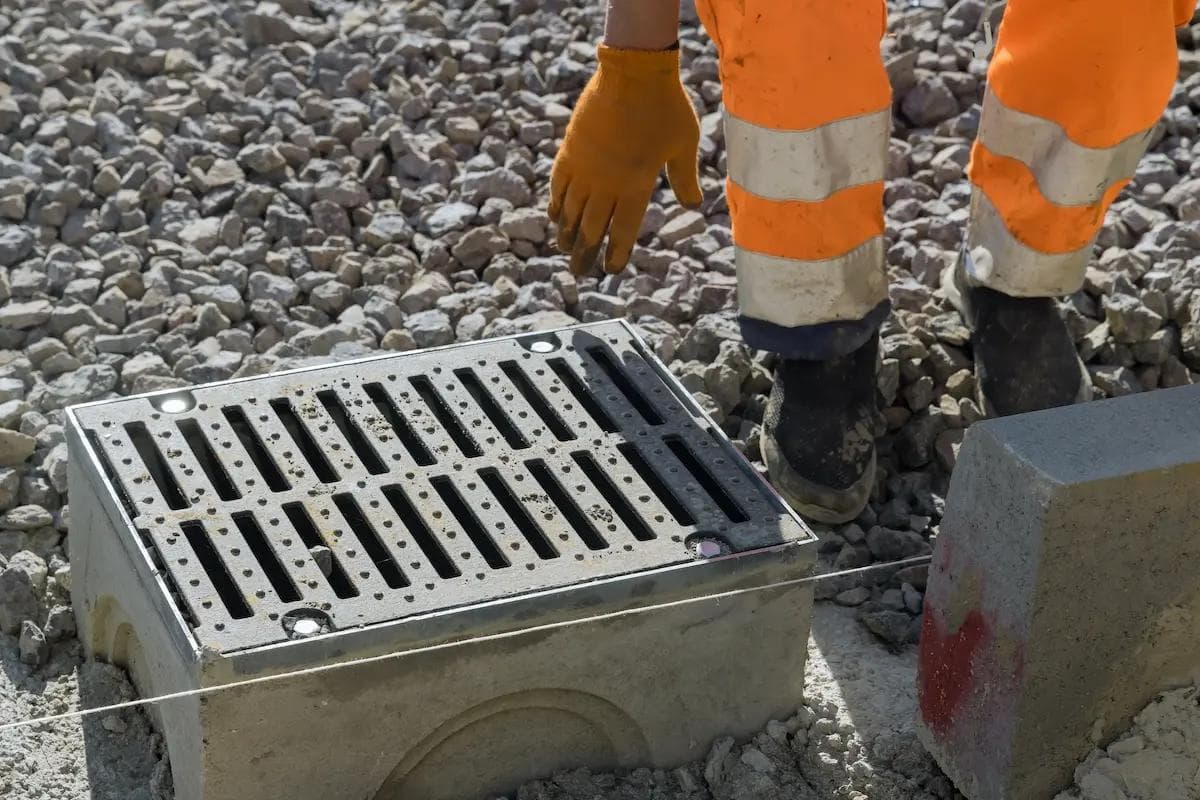
Cons of using crushed concrete
Although it can save you a lot of money, and help reduce the amount of material going to landfill, there are some drawbacks of using crushed concrete for your projects.
It might not be as strong
When it comes to using crushed concrete, durability can be a problem. Although crushed concrete will compact and harden over time, it may not be as strong as the original concrete structure or stone. Some studies show that the strength of recycled concrete is between 90% and 70% compared to freshly poured concrete.
It's important to check the quality and grade of recycled concrete before using it in another project to make sure it is safe and it will last. Otherwise, you could be left with roads and driveways that are full of dents and potholes.
If you’re using crushed concrete for structural work or high-load applications, consider blending it with virgin aggregate to increase compressive strength and consistency. Using a screener to separate fines from larger chunks can also improve compaction performance and surface quality.
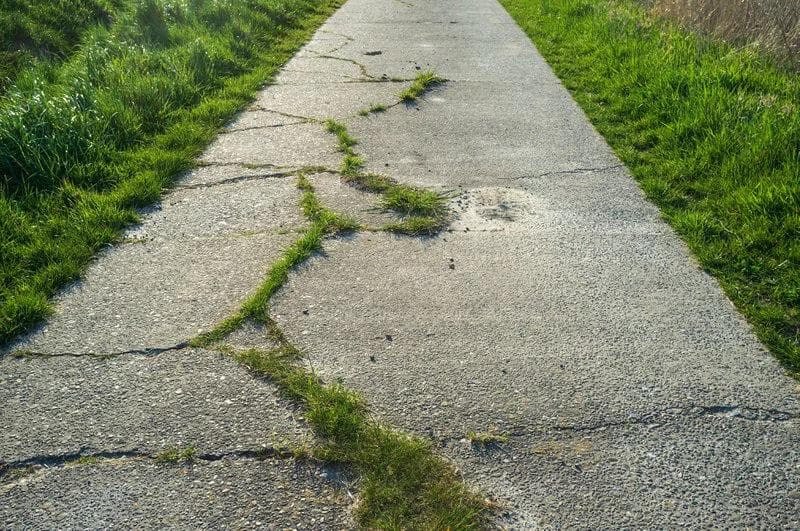
It might not look as nice
Recycled crushed concrete has a bad reputation for not looking as nice as fresh concrete. For projects that need ‘pretty looking’ concrete, RCA might not be the best choice but it can still be used for ones that require durable materials at a cost-effective price. It’s also still great for using as base or fill - especially if it is going to be covered over.
However, newer screening and washing technologies can produce recycled concrete with a cleaner, more uniform appearance. Some suppliers even offer blended RCA products that are visually consistent enough for exposed aggregate or landscape applications.
The quality can be lower
It can often be contaminated with materials from job sites such as glue, metal rebar, and plastics depending on the original source of the concrete. This contamination can make it difficult to use for certain projects and make the concrete less durable. It's important to work with a supplier that has clear standards for quality assurance and strives to produce clean, uncontaminated material.
Quality control during crushing, like using magnetic separators to remove rebar and pre-screening for debris, can ensure the final recycled aggregate meets specification for DOT or commercial use. Choosing clean RCA improves drainage, compaction, and long-term stability.

Water absorption
Recycled crushed concrete can soak up more water than new concrete - as much as 9% of its weight. While water is important for the concrete to harden, too much of it can cause problems. Too much water can make the concrete crack, weaken it, and look bad. It can also cause the concrete to expand, resulting in "popouts" where cone-shaped pieces break off from the surface - not good!
This happens because recycled concrete aggregate has more porous surfaces than virgin stone. To minimize absorption issues, contractors can use sealing compounds, geotextile layers, or blended base mixes with lower moisture retention.

How much does crushed concrete cost compared to other materials?
Crushed concrete is a fantastic alternative to using granite and virgin aggregate in construction projects. Not only does it provide structural strength, but it's also a much more cost-effective option.
The price of crushed concrete varies between states, but it's generally much more affordable than other materials like granite and virgin aggregate. To learn more about the price & how to find crushed concrete and crushed stone near you, check out our linked blogs. You may even be thinking about making your own crushed concrete ... this blog has all the information you need!
Prices can range from $10 to $35 per ton, depending on quality, size, and location. Contractors who crush on-site can cut those costs even further by eliminating transport and supply-chain markups. Many small operators achieve break-even on their crusher investment in less than a year by processing waste concrete into reusable aggregate.

Real-World Application: Turning Demo Concrete Into Profit
Fabian, owner of Royal Pavers, used to haul away broken concrete from his paving jobs, paying high disposal fees and buying new base material for every project. With support from Machinery Partner, he added a compact crusher and screener setup to his business. Now he crushes old concrete directly on-site, reuses it as base for new installs, and even sells the excess.
This shift helped Fabian cut operating costs, reduce downtime, and turn what used to be waste into a consistent revenue stream. It's a clear example of how small to mid-sized contractors can stay efficient and profitable by recycling concrete with the right equipment.
Fabian’s operation shows how using portable crushers, conveyors, and screeners creates a full concrete recycling loop. Contractors no longer need to depend on third-party quarries or waste facilities. They can process, store, and reuse aggregate right at the job site.
When to Use Crushed Concrete vs. When to Avoid It
Crushed concrete works well for base layers, drainage fill, driveways, and parking pads, especially when you’re looking for cost savings and a sustainable option. But it’s not always the right material. You may want to avoid it for high-strength poured structural concrete or exposed finish surfaces, where consistent texture and mix design are critical.
Knowing where crushed concrete fits (and where it doesn’t) helps contractors avoid callbacks and ensures your project meets spec.
Use RCA where compaction, stability, and drainage matter most, like under roads, walkways, or as subbase for foundations. Avoid it where compressive strength or visual finish is key, such as load-bearing walls or exposed decorative applications.
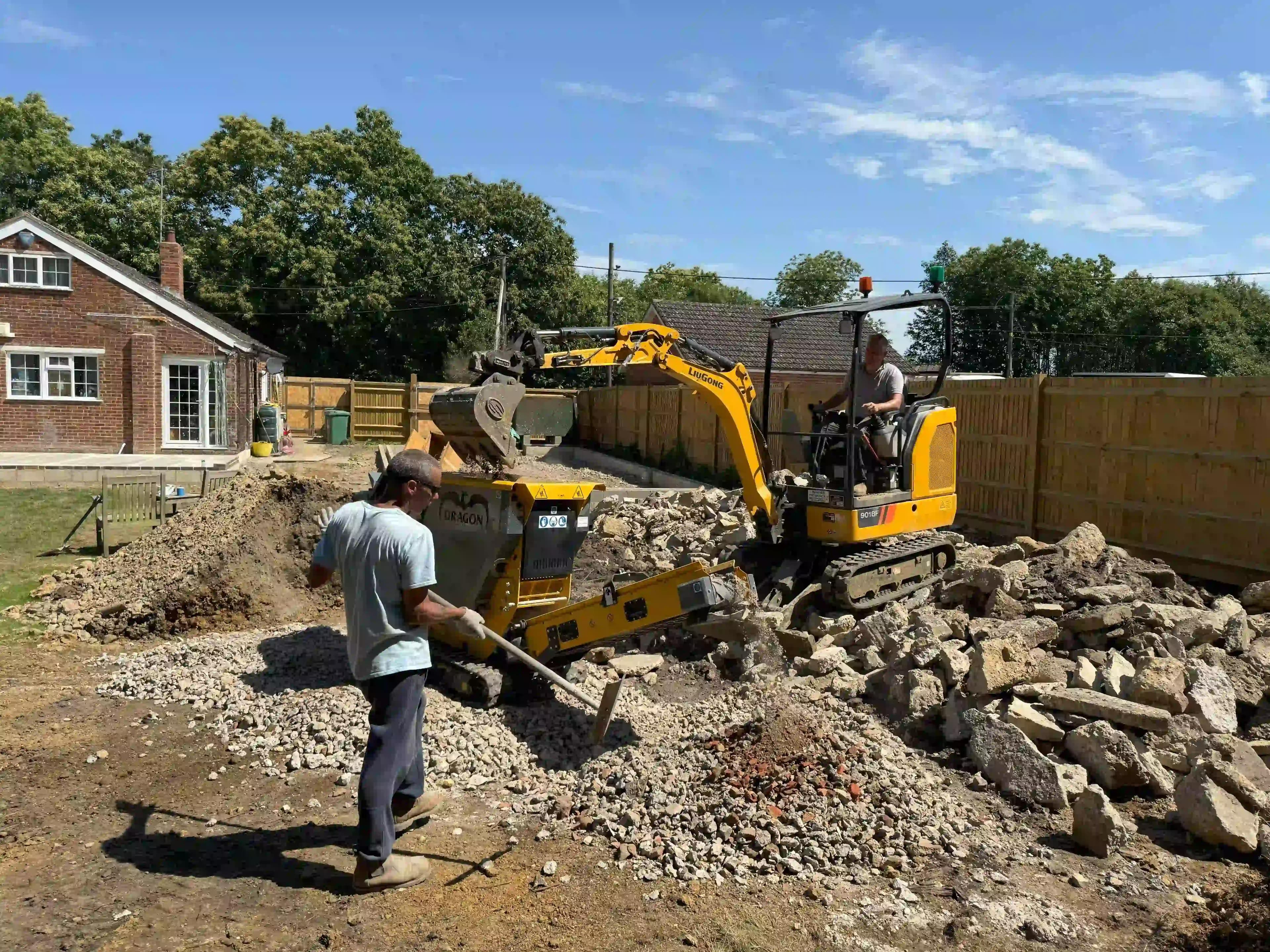
How to Start Crushing Concrete on Site
If you're generating concrete waste on your jobs, crushing it on-site could be a fast win. A small tracked jaw crusher can handle demo slabs, sidewalks, and curbing, producing clean base material with minimal handling. Pairing that with a screener lets you separate fines from larger aggregate, giving you two or more usable products from the same pile.
Start by estimating how much concrete you produce monthly, then calculate what you're paying in haul-off and aggregate costs. For many contractors, on-site crushing pays for itself in under 12 months.
Mobile crushers like compact jaw or impact models make it easy for small crews to recycle concrete without disrupting daily operations. Some units can process up to 50 tons per hour, letting you crush material as you go and reuse it for immediate backfill or road base.
Is crushed concrete good for driveways?
Crushed concrete is an excellent choice for people who are looking for a driveway material that offers superior drainage and durability at an affordable price.
Unlike gravel, crushed concrete minimizes puddles and mud patches, making it a great option for areas with high rainfall. It is also much more affordable than other paving materials like asphalt or concrete, often costing up to 50% less!
Crushed concrete requires minimal maintenance, saving you both time and money. It’s easy-to-clean surface means you won't need to make frequent trips to the store for repair supplies, and the use of recycled construction materials lowers the amount of waste that ends up in landfills. By choosing crushed concrete, you can enjoy a low-maintenance, eco-friendly, and cost-effective driveway that will last for years to come.
Contractors also prefer RCA driveways for their ability to drain water efficiently, preventing frost heave and surface cracking. When compacted properly, a crushed concrete driveway can last as long as traditional gravel—without the high material cost.

Find out more - with the help of Machinery Partner
For more information on crushed concrete or if you are thinking of crushing your own material - Machinery Partner are here to help! With a full range of crushers, screeners, burners & more - call today!
Our experts can help you choose the best crusher setup for your material type and volume, ensuring you produce clean, consistent recycled concrete aggregate with maximum efficiency.
FAQs: Crushed Concrete
What is crushed concrete?
Crushed concrete, also known as recycled concrete aggregate (RCA), is produced by breaking down concrete from demolished structures into smaller pieces. It's commonly used as a base material in construction projects. RCA serves as a direct substitute for virgin aggregate, delivering comparable compaction and load-bearing strength at a fraction of the cost.
How is crushed concrete made?
The process involves collecting concrete debris, removing contaminants like rebar, and crushing the material into desired sizes using industrial equipment. Contractors may use jaw crushers, impact crushers, or cone crushers depending on the hardness and size of the material being processed. Screeners are then used to sort the material by size for different applications.
What are the benefits of using crushed concrete?
Benefits include cost savings, reduced landfill waste, and conservation of natural resources. It's also versatile for various construction applications. It’s a popular choice for both residential and commercial projects because it combines sustainability with high performance for base layers, drainage, and paving.
Are there any drawbacks to using crushed concrete?
Potential drawbacks include variability in material quality and slightly lower strength compared to new aggregates. It's essential to ensure the crushed concrete meets project specifications. Working with a reliable recycling provider or producing your own crushed material ensures consistency and reduces contamination risks.
Can crushed concrete be used for driveways?
Yes, it's a popular choice for driveways due to its affordability and durability. However, proper installation and compaction are crucial for longevity. Adding a layer of fine RCA or screenings on top can create a smoother finish and reduce dust—making crushed concrete an excellent all-around driveway solution.







